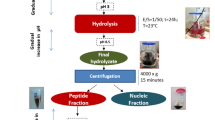Abstract
Bovine hemoglobin is the major component of the cruor (slaughterhouse by-product) and can be considered as an important source of active peptides that could be obtained by pepsic hydrolysis. The kinetics of appearance and disappearance of several antibacterial peptides from α 1–32 family during hydrolysis of synthesized α 1–32 peptide, of purified bovine hemoglobin and of cruor was studied, and reaction scheme for the hydrolysis of α 1–32 family peptides from these three sources was determined. On this basis, a mathematical model was proposed to predict the concentration of each peptide of interest of this family depending on hydrolysis time, and also on temperature (in the range 15–37 °C), pH (in the range 3.5–5.5) and enzyme to substrate ratio (in the range 1/50–1/200 for the synthesized peptide and 1/5–1/20 for purified bovine hemoglobin and cruor). Apparent rate constants of reactions were determined by applying the model on a set of experimental data and it was shown that they depended on the temperature according to Arrhenius’s law, that their dependence on the pH was linear, and that enzyme to substrate ratio influence was limited (in the studied range).




Similar content being viewed by others
References
Ivanov VT, Karelin AA, Philippova MM, Nazimov IV, Pletnev VZ (1997) Hemoglobin as a source of endogenous bioactive peptides: the concept of tissue-specific peptide pool. Biopolymers 43:171–188
Brantl V, Gramsch C, Lottspeich F, Mertz R, Jaeger KH, Herz A (1986) Novel opioid peptides derived from hemoglobin: hemorphins. Eur J Pharmacol 125:309–310
Linderstrom-Lang K (1952) The initial stages in the breakdown of proteins by enzymes. Proteins and enzyme III. Lanes medical lectures. Stanf Univ Press Calif 6:53–72
Barkhudaryan N, Kellermann J, Galoyan A, Lottspeich F (1993) High molecular weight aspartic endopeptidase generates a coronaro-constrictory peptide from the beta-chain of hemoglobin. FEBS Lett 329:215–218
Lignot B, Froidevaux R, Nedjar-Arroume N, Guillochon D (1999) Solvent effect on kinetics of appearance of neokyotorphin VVh4 and a bradykinin-potentiating peptide in the course of peptic hydrolysis of bovine haemoglobin. Biotechnol Appl Biochem 30:201–207
Zhao Q, Piot JM (1997) Investigation of inhibition angiotensin-converting enzyme (ACE) activity and opioid activity of two hemorphins, LVV-hemorphin-5 and VV-hemorphin-5, isolated from a defined peptic hydrolysate of bovine hemoglobin. Neuropeptides 2:147–153
Piot JM, Zhao QY, Guillochon D, Ricart G, Thomas D (1992) Isolation and characterization of a bradykinin potentiating peptide from a bovine peptic hemoglobin hydrolysate. FEBS Lett 299:75–79
Lebrun F, Bazus A, Dhulster P, Guillochon D (1998) Solubility of heme in heme-iron enriched bovine haemoglobin hydrolysates. J Agric Food Chem 46:5017–5025
Zhao Q, Piot JM, Gauthier V, Cottenceau G (1996) Isolation and characterization of a bacteria growth stimulating peptide from a peptic bovine hemoglobin hydrolysate. Appl Microbiol Biotechnol 45:778–784
Yaba Adjé E, Balti R, Kouach M, Guillochon D, Nedjar-Arroume N (2011) α67-106 of bovine hemoglobin: a new family of antimicrobial and angiotensin I-converting enzyme inhibitory peptides. Eur Food Res Technol 232:637–646
Choisnard L, Froidevaux R, Nedjar-Arroume N, Lignot B, Vercaigne-Marko D, Krier F (2002) Kinetic study of the appearance of an anti-bacterial peptide in the course of bovine haemoglobin peptic hydrolysis. Biotechnol Appl Biochem 36:187–194
Daoud R, Dubois V, Bors-Dodita L, Nedjar-Arroume N, Krier F, Chihib N (2005) New antibacterial peptide derived from bovine hemoglobin. Peptides 26:713–719
Froidevaux R, Krier F, Nedjar-Arroume N, Vercaigne-Marko D, Kosciarz E, Ruckebusch C (2001) Antibacterial activity of a pepsin-derived bovine hemoglobin fragment. FEBS Lett 491:159–163
Nedjar-Arroume N, Dubois-Delval V, Adje EY, Traisnel J, Krier F, Mary P, Kouach M, Briand G, Guillochon D (2008) Bovine hemoglobin: an attractive source of antibacterial peptides. Peptides 29:969–977
Vercaigne-Marko D, Kosciarz E, Nedjar-Arroume N, Guillochon D (2000) Improvement of Staphylococcus aureus-V8-protease hydrolysis of bovine haemoglobin by its adsorption on to a solid phase in the presence of SDS: peptide mapping and obtention of two haemopoietic peptides. Biotechnol Appl Biochem 2:127–134
Nedjar-Arroume N, Dubois-Delval V, Miloudi K, Daoud R, Krier F, Kouach M, Briand G, Guillochon D (2006) Isolation and characterization of four antibacterial peptides from bovine hemoglobin. Peptides 27:2082–2089
Hedhili K, Vauchel P, Dimitrov K, Kriaa K, Chataigné G, Hani K, Dhulster P, Nedjar-Arroume N (2014) Mechanism and kinetics modeling of the enzymatic hydrolysis of α1–32 antibacterial peptide. Bioprocess Biosyst Eng 37:1315–1323
Catiau L, Traisnel J, Chihib NE, Le Flem G, Blanpain A, Melnyk O, Guillochon D, Nedjar-Arroume N (2011) RYH: a minimal peptidic sequence obtained from beta-chain hemoglobin exhibiting an antimicrobial activity. Peptides 32:1463–1468
Dubois V, Nedjar-Arroume N, Guillochon D (2005) Influence of pH on the appearance of active peptides in the course of peptic hydrolysis of bovine haemoglobin. Prep Biochem Biotechnol 35(2):85–102
Author information
Authors and Affiliations
Corresponding author
Rights and permissions
About this article
Cite this article
Hedhili, K., Dimitrov, K., Vauchel, P. et al. Valorization of cruor slaughterhouse by-product by enzymatic hydrolysis for the production of antibacterial peptides: focus on α 1–32 family peptides mechanism and kinetics modeling. Bioprocess Biosyst Eng 38, 1867–1877 (2015). https://doi.org/10.1007/s00449-015-1427-2
Received:
Accepted:
Published:
Issue Date:
DOI: https://doi.org/10.1007/s00449-015-1427-2




